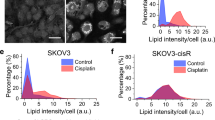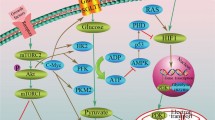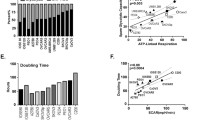Abstract
Background
Malignant transformation of cells is often accompanied by up-regulation of glycolysis-related enzymes and transporters, as well as a distortion of mitochondrial respiration. As a consequence, most malignant tumors utilize high amounts of glucose and produce and accumulate high concentrations of lactate, even in the presence of oxygen. This phenomenon has been termed ‘Warburg Effect’. Here, we aimed at resolving the interrelation between tumor metabolism, reactive oxygen species, double strand DNA breaks and radio-resistance in ovarian cancer-derived cells.
Methods
As a model system two ovarian cancer-derived cell lines, OC316 and IGROV-1, and its corresponding xenografts were used. First, the metabolic properties of the xenografts were tested to ensure that initial in vitro data might later be transferred to in vivo data. In parallel, three inhibitors of tumor cell metabolism, 2-deoxy-D-glucose, an inhibitor of glycolysis, oxamate, a pyruvate analogue and inhibitor of lactate dehydrogenase, and rotenone, a specific inhibitor of mitochondrial electron complex I, were tested for their effect on the metabolism and radio-sensitivity of the respective ovarian cancer-derived cell lines.
Results
We found that all three inhibitors tested led to significant changes in the tumor cell energy metabolism at non-cytotoxic concentrations. Furthermore, we found that inhibition of tumor glycolysis by 2-deoxy-D-glucose in combination with rotenone decreased the radio-resistance at a clinically relevant radiation dose. This apparent radio-sensitizing effect appears to be based on an increased level of double strand DNA breaks 1 h and 24 h after gamma irradiation. Both cancer-derived cell lines maintained their metabolic properties, as well as their protein expression profiles and levels of reactive oxygen species in xenografts, thus providing a suitable model system for further in vivo investigations.
Conclusion
A combination of metabolic inhibitors and reactive oxygen species-generating therapies, such as irradiation, may effectively enhance the therapeutic response in particularly metabolically highly active (ovarian) tumors.





Similar content being viewed by others
References
A. Geurts van Kessel, The cancer genome: from structure to function. Cell. Oncol. 37, 155–165 (2014)
O. Warburg, On the origin of cancer cells. Science 123, 309–314 (1956)
J.P. Bayley, P. Devilee, The Warburg effect in 2012. Curr. Opin. Oncol. 24, 62–67 (2012)
V. Gogvadze, B. Zhivotovsky, S. Orrenius, The Warburg effect and mitochondrial stability in cancer cells. Mol. Asp. Med. 31, 60–74 (2010)
W.H. Koppenol, P.L. Bounds, C.V. Dang, Otto Warburg’s contributions to current concepts of cancer metabolism. Nat. Rev. Cancer 11, 325–337 (2011)
A. Herling, M. Konig, S. Bulik, H.G. Holzhutter, Enzymatic features of the glucose metabolism in tumor cells. FEBS J. 278, 2436–2459 (2011)
H.R. Oh, C.H. An, N.J. Yoo, S.H. Lee, Somatic mutations of amino acid metabolism-related genes in gastric and colorectal cancers and their regional heterogeneity—a short report. Cell. Oncol. 37, 455–461 (2014)
D.M. Brizel, T. Schroeder, R.L. Scher, S. Walenta, R.W. Clough, M.W. Dewhirst, W. Mueller-Klieser, Elevated tumor lactate concentrations predict for an increased risk of metastases in head-and-neck cancer. Int. J. Radiat. Oncol. Biol. Phys. 51, 349–353 (2001)
S. Walenta, M. Wetterling, M. Lehrke, G. Schwickert, K. Sundfor, E.K. Rofstad, W. Mueller-Klieser, High lactate levels predict likelihood of metastases, tumor recurrence, and restricted patient survival in human cervical cancers. Cancer Res. 60, 916–921 (2000)
V. Quennet, A. Yaromina, D. Zips, A. Rosner, S. Walenta, M. Baumann, W. Mueller-Klieser, Tumor lactate content predicts for response to fractionated irradiation of human squamous cell carcinomas in nude mice. Radiother. Oncol. 81, 130–135 (2006)
U.G. Sattler, S.S. Meyer, V. Quennet, C. Hoerner, H. Knoerzer, C. Fabian, A. Yaromina, D. Zips, S. Walenta, M. Baumann, W. Mueller-Klieser, Glycolytic metabolism and tumour response to fractionated irradiation. Radiother. Oncol. 94, 102–109 (2010)
F. Hirschhaeuser, U.G. Sattler, W. Mueller-Klieser, Lactate: a metabolic key player in cancer. Cancer Res. 71, 6921–6925 (2011)
U.G. Sattler, W. Mueller-Klieser, The anti-oxidant capacity of tumour glycolysis. Int. J. Radiat. Biol. 85, 963–971 (2009)
U.G. Sattler, F. Hirschhaeuser, W.F. Mueller-Klieser, Manipulation of glycolysis in malignant tumors: fantasy or therapy? Curr. Med. Chem. 17, 96–108 (2010)
C. Fabian, L. Koetz, E. Favaro, S. Indraccolo, W. Mueller-Klieser, U.G. Sattler, Protein profiles in human ovarian cancer cell lines correspond to their metabolic activity and to metabolic profiles of respective tumor xenografts. FEBS J. 279, 882–891 (2012)
J. Benard, S.J. Da, M.C. De Blois, P. Boyer, P. Duvillard, E. Chiric, G. Riou, Characterization of a human ovarian adenocarcinoma line, IGROV1, in tissue culture and in nude mice. Cancer Res. 45, 4970–4979 (1985)
A. Alama, F. Barbieri, A. Favre, M. Cagnoli, E. Noviello, F. Pedulla, M. Viale, G. Foglia, N. Ragni, Establishment and characterization of three new cell lines derived from the ascites of human ovarian carcinomas. Gynecol. Oncol. 62, 82–88 (1996)
E. Favaro, G. Nardo, L. Persano, M. Masiero, L. Moserle, R. Zamarchi, E. Rossi, G. Esposito, M. Plebani, U. Sattler, T. Mann, W. Mueller-Klieser, V. Ciminale, A. Amadori, S. Indraccolo, Hypoxia inducible factor-1alpha inactivation unveils a link between tumor cell metabolism and hypoxia-induced cell death. Am. J. Pathol. 173, 1186–1201 (2008)
S. Domcke, R. Sinha, D.A. Levine, C. Sander, N. Schultz, Evaluating cell lines as tumour models by comparison of genomic profiles. Nat. Commun. 4, 2126 (2013)
C.J. Lord, A. Ashworth, Mechanisms of resistance to therapies targeting BRCA-mutant cancers. Nat. Med. 19, 1381–1388 (2013)
C. Arienti, A. Tesei, S. Carloni, P. Ulivi, A. Romeo, G. Ghigi, E. Menghi, A. Sarnelli, E. Parisi, R. Silvestrini, W. Zoli, SLUG silencing increases radiosensitivity of melanoma cells in vitro. Cell. Oncol. 36, 131–139 (2013)
Y. Zhou, E.O. Hileman, W. Plunkett, M.J. Keating, P. Huang, Free radical stress in chronic lymphocytic leukemia cells and its role in cellular sensitivity to ROS-generating anticancer agents. Blood 101, 4098–4104 (2003)
J.P. Fruehauf, F.L. Meyskens Jr., Reactive oxygen species: a breath of life or death? Clin. Cancer Res. 13, 789–794 (2007)
M.A. Fath, A.R. Diers, N. ykin-Burns, A.L. Simons, L. Hua, D.R. Spitz, Mitochondrial electron transport chain blockers enhance 2-deoxy-D-glucose induced oxidative stress and cell killing in human colon carcinoma cells. Cancer Biol. Ther. 8, 1228–1236 (2009)
N. Li, K. Ragheb, G. Lawler, J. Sturgis, B. Rajwa, J.A. Melendez, J.P. Robinson, Mitochondrial complex I inhibitor rotenone induces apoptosis through enhancing mitochondrial reactive oxygen species production. J. Biol. Chem. 278, 8516–8525 (2003)
H. Pelicano, L. Feng, Y. Zhou, J.S. Carew, E.O. Hileman, W. Plunkett, M.J. Keating, P. Huang, Inhibition of mitochondrial respiration: a novel strategy to enhance drug-induced apoptosis in human leukemia cells by a reactive oxygen species-mediated mechanism. J. Biol. Chem. 278, 37832–37839 (2003)
Y. Zhao, H. Liu, Z. Liu, Y. Ding, S.P. Ledoux, G.L. Wilson, R. Voellmy, Y. Lin, W. Lin, R. Nahta, B. Liu, O. Fodstad, J. Chen, Y. Wu, J.E. Price, M. Tan, Overcoming trastuzumab resistance in breast cancer by targeting dysregulated glucose metabolism. Cancer Res. 71, 4585–4597 (2011)
D.A. Tennant, R.V. Duran, E. Gottlieb, Targeting metabolic transformation for cancer therapy. Nat. Rev. Cancer 10, 267–277 (2010)
Financial Support
Deutsche Forschungsgemeinschaft DFG (SA 1749/3-1; MU 576/15-1); Universita’ di Padova – Progetto d’Ateneo 2010 to S.I.; AIRC (Project n. IG14295).
Conflict of interest
The authors declare that they have no conflict of interest.
Author information
Authors and Affiliations
Corresponding author
Additional information
Kristina Goetze and Christian G. Fabian shared first authorship
Rights and permissions
About this article
Cite this article
Goetze, K., Fabian, C.G., Siebers, A. et al. Manipulation of tumor metabolism for therapeutic approaches: ovarian cancer-derived cell lines as a model system. Cell Oncol. 38, 377–385 (2015). https://doi.org/10.1007/s13402-015-0237-5
Accepted:
Published:
Issue Date:
DOI: https://doi.org/10.1007/s13402-015-0237-5




